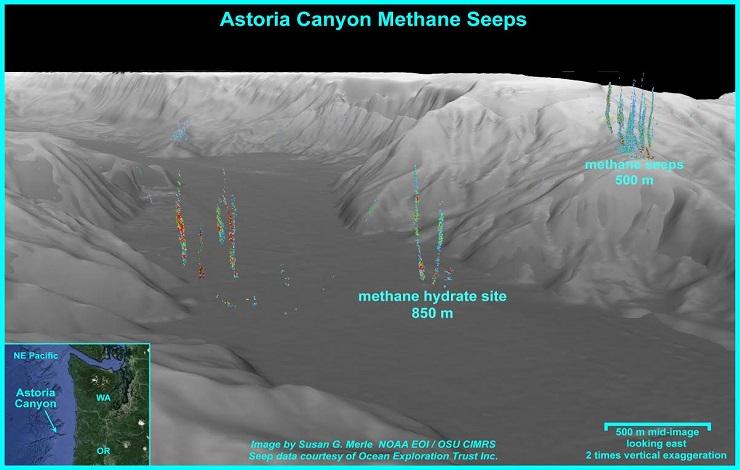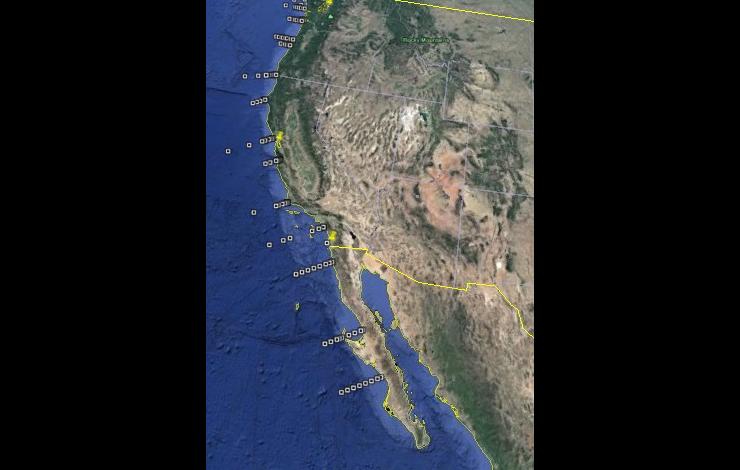What's New Archive
On June 29 at 8:30 pm EDT, an episode for the Changing Seas TV series will air on WPBT2 focusing on PMEL’s May 2014 expedition to Maug Island, about 450 miles north of Guam to study volcanic ocean acidification. Maug provides scientists with an extraordinary natural laboratory for ocean acidification research. Watch the full episode on the Changing Seas TV YouTube Channel. WPBT2, South Florida PBS, produced the episode along with Open Boat Films.
In May 2014, OAR/PMEL’s Earth-Ocean Interactions (EOI) group and NMFS/ Pacific Island Fisheries Science Center (PIFSC)’s Coral Reef Ecosystem Division led a week-long expedition on the NOAA ship Hi’ialakai to Maug Island in the northern Marianas to study the effects of ocean acidification on marine ecosystems. Maug is a flooded caldera where volcanic CO2 vents directly into a shallow coral reef ecosystem. The gas emitted by the vents change the chemistry of the seawater around the reefs in a process similar to global ocean acidification.
EOI scientists that were aboard the cruise included Pamela Barrett, David Butterfield, Nathan Buck and Ben Larson from the Joint Institute for the Study of the Atmosphere and Ocean at the University of Washington (UW) and Susanna Michael, a graduate student at UW's School of Oceanography.
This summer, NOAA’s Pacific Marine Environmental Lab is mentoring six undergraduate Hollings scholars and one NSF research experience for undergraduates (REU) student. These students come from all over the United States and all have a passion for the marine environment. The summer internships provide each student with hands-on research experience as they work closely with a mentor. This year, the undergraduates are placed in the Acoustics, Arctic, Carbon, Ocean Climate Stations, Atmospheric Chemistry and Large Scale Ocean Physics groups and are located in Seattle, WA and Newport, OR.
We are very excited to have this year’s cohort: Abigail Birnbaum, Leah Chomiak, Allison Hogikyan, Gabriella Kalbach, Cordelia Sanborn-Marsh, Meghan Shea, and Audrey Taylor. Read more about each Hollings Scholar and our NSF-REU student on our education page.
Learn more about NOAA’s Ernest F. Hollings (Hollings) Undergraduate Program and the National Science Foundation Research Experience for Undergraduate (NSF-REU) program.
The Ocean Exploration Trust Inc. ship E/V Nautilus, with several NOAA-PMEL and Oregon State University CIMRS scientists aboard, is using the latest midwater sonar technology to map out methane seeps along the Cascadia continental margin this month. PMEL/CIMRS scientists report that, after locating extensive bubble plumes of methane in Astoria canyon at 850 m, the remotely operated vehicle Hercules visited the site and found an exposure of methane hydrate and gas bubbles streaming out of the seafloor. The hydrate, a mixed water/methane ice phase, is present over extensive areas of continental margins, but has only rarely been observed exposed at the seafloor along the Cascadia margin. Why the hydrate is exposed at this location in association with the methane gas seepage is a topic of discussion among the scientists aboard the Nautilus and those ashore participating remotely via the internet. The E/V Nautilus is a unique platform with extensive telepresence capability that enables scientist aboard to interact with those in the broader scientific community and the public ashore. Dives with the Hercules are broadcast live over the internet and can be viewed at http://www.nautiluslive.org/
On June 5th, the Arctic Heat Open Science Experiment (Arctic Heat) began over the Chukchi and Beaufort Seas, in the Alaskan Arctic, to collect data to support sea ice and weather forecasting. PMEL will be leading flights aboard a specially-outfitted NOAA Twin Otter aircraft that will be operating during the summer to launch autonomous floats, MRV’s Air-Launched Autonomous Micro-Observer “ALAMO”, and to rapidly collect data over a wide area.
The Chukchi Sea and other seasonally ice-free marginal seas are among the most challenging regions to study because for much of the year the sea ice is not stable enough to deploy equipment on and it can easily wreak havoc on most instruments in the water. Ships and satellites only provide limited access to this domain, and so the progress of research is impeded by the lack of observations.
Arctic Heat is a joint effort of NOAA Pacific Marine Environmental Laboratory (PMEL) Arctic Research, the Innovative Technology for Arctic Exploration (ITAE) program, the ALAMO development group at the Woods Hole Oceanographic Institution, and the Joint Institute for the Study of the Atmosphere and Ocean (JISAO) at the University of Washington.
Through September, PMEL and Alaska Fisheries Science Center (AFSC) are testing innovative technologies to survey the Bering Sea. PMEL is once again utilizing the Saildrone, a solar and wind powered unmanned autonomous vehicle developed by Saildrone Inc., as a research platform. Two Saildrones launched from Dutch Harbor, AK on May 23, each equipped with suites of meteorological and oceanographic sensors, plus specially developed echo sounders and modified whale acoustic hydrophones.
Following the successful 2015 oceanographic field trials, the 2016 mission combines both physical and biological oceanography to seek out new ways to supplement traditional vessel-based research. Oceanographic and fisheries data will be validated to the NOAA Ship Oscar Dyson and PMEL moorings.
Watch the YouTube Broadcast to hear more from the scientists involved. Read more about the mission here and at NOAA Research.
Follow along with the saildrone on the Innovative Technology for Arctic Exploration site.

Launching Hercules off stern of E/V Nautilus. www.nautiluslive.org
PMEL scientists from the Earth-Ocean Interactions Program will be on board the E/V Nautilus, which is operated by the Ocean Exploration Trust (OET), during June 1-20. This expedition will explore and characterize habitats and methane seeps along the Cascadia continental margin between northern Washington and Cape Mendocino. Broadband video of the seafloor during the dives from OET remotely operated vehicle Hercules will be broadcast in realtime over the internet. Scientists ashore representing a broad range of expertise will also participate via a realtime link to the ship during the dives.
Follow along live and learn more about the cruise on: http://www.nautiluslive.org
PMEL climate scientists describe in a recently published paper the relationship between the 2014-15 failed El Niño and this year’s monster El Niño as well as any similarities between the past strong El Niño’s. They examined changes in sea surface and sub-surface temperatures, winds, and volumes of warm water in the Pacific Ocean from 2014 to 2016.
What they found was that the highly anticipated 2014-15 El Niño event failed due to unusually strong easterly winds in the summer of 2014 which prevented the warm surface water from shifting eastward as seen in a typical El Niño events and left a reservoir of warm water below the ocean’s surface. This reservoir of warm water combined with strong westerly winds that appeared and continued throughout the spring and summer of 2015 led to the monster El Niño. They found a similar series of events that led to the 1991-92 El Nino event.
Learn more about El Nino Research and read AGU’s press release on the paper.
The Synthesis of Arctic Research (SOAR) project published an update on May 9, 2016 that highlights how the Pacific Arctic’s new normal conditions are affecting a variety of marine life. SOAR is 6-year interdisciplinary effort led by PMEL and Fisheries scientists that provides a synthetic view of recent changes in the Pacific Arctic marine ecosystem. These recent changes include longer open-water periods during the summer, fewer days of sea ice cover, reduced sea ice thickness, increased growing season of marine algae and lower pH. A second Special Issue is currently underway and builds on themes and new understanding described in the first Special Issue that featured 17 papers from over 100 contributors.
Through collaboration and synthesis, SOAR is increasing scientific understanding of the complex relationships among oceanographic conditions (physics, chemistry, sea ice), and species in various levels of the food web (from zooplankton and forage fish to seabirds and marine mammals), in the rapidly changing Pacific Arctic marine ecosystem.
Read the project update on Eos, the news arm of the American Geophysical Union.
PMEL scientists are leading the most integrated research cruise that launches May 5th from San Diego. The research cruise takes place every couple years and allows NOAA to create a unique time series of carbon measurements in areas expected to be highly impacted by ocean acidification. Some 36 scientists from the United States, Mexico, Canada and Europe will be aboard the NOAA Ship Ronald H. Brown throughout the month long cruise to get a better understanding of changing ocean conditions and biological responses.
Scientists from NOAA’s Northwest Fisheries Science Center and the Romberg Tiburon Center will study how ocean acidification contributes to harmful algal blooms. For the first time on this expedition, NOAA is collaborating with the Department of Interior’s National Park Service who will assist in collecting on-shore samples at three different parks: Cabrillo National Monument, Channel Islands National Park, and Olympic National Park. PMEL has continued to partner with the West Coast National Marine Sanctuaries to also collect on shore samples. Sampling on-shore while the ship is nearby will allow scientists to understand the relationship between nearshore and offshore conditions.
Follow along with the expedition through the cruise’s blog. To read more visit NOAA.gov and the Carbon program's page.
PMEL scientists from the Earth-Ocean Interactions Program will be remotely joining the NOAA Ship Okeanos Explorer on its deep-water exploration of the Mariana region via “telepresence” from Newport, OR and Seattle, WA. PMEL will lead three remotely operated vehicle (ROV) dives tentatively scheduled for this weekend. These dives will explore three hydrothermal vent sites that were recently discovered on an R/V Falkor research cruise conducted in fall 2015. This region is home to the deepest parts of the ocean, the Mariana Trench, and hydrothermal vents with unique marine ecosystems in diverse geologic settings.
The main goal of the expedition is to collect baseline information of unknown and poorly known areas in and around the Mariana region to support science and management needs, and to understand the diversity and distribution of deep-water habitats. The expedition continues through July 10.
Follow along live and learn more about the cruise on the NOAA Ocean Exploration Program web site.











